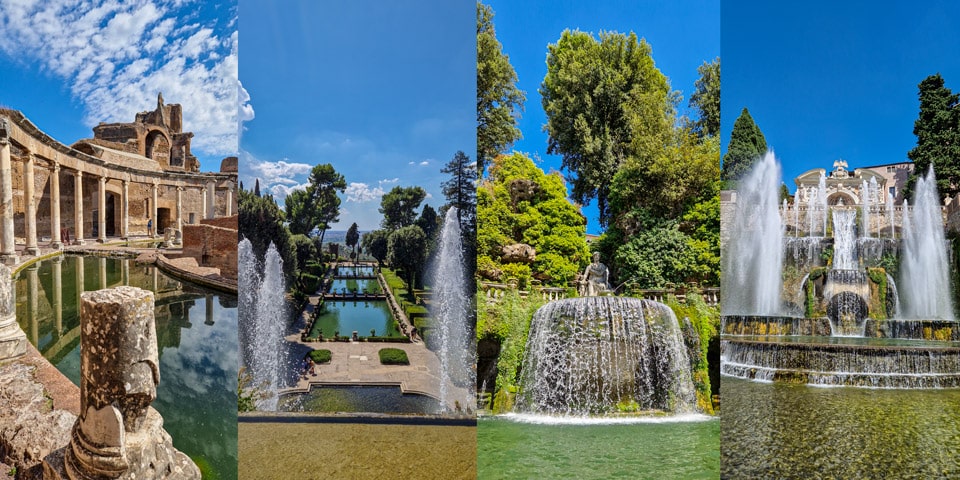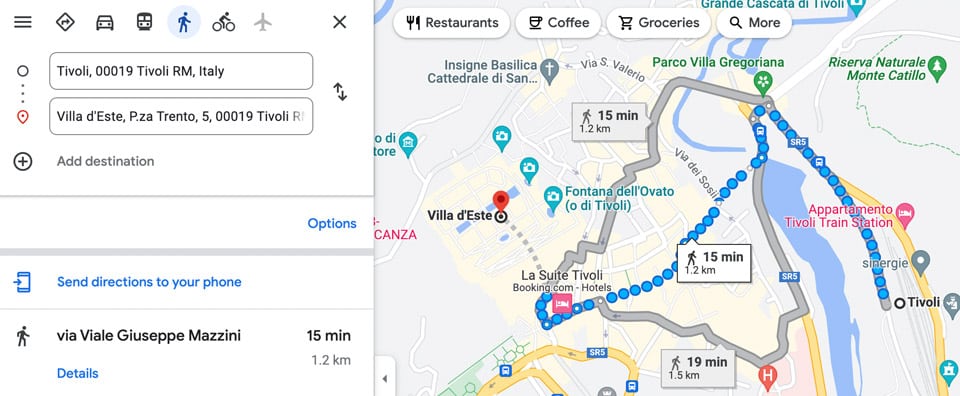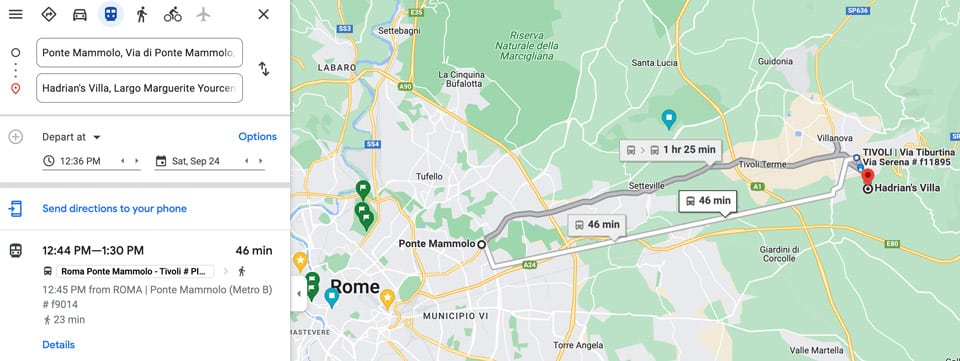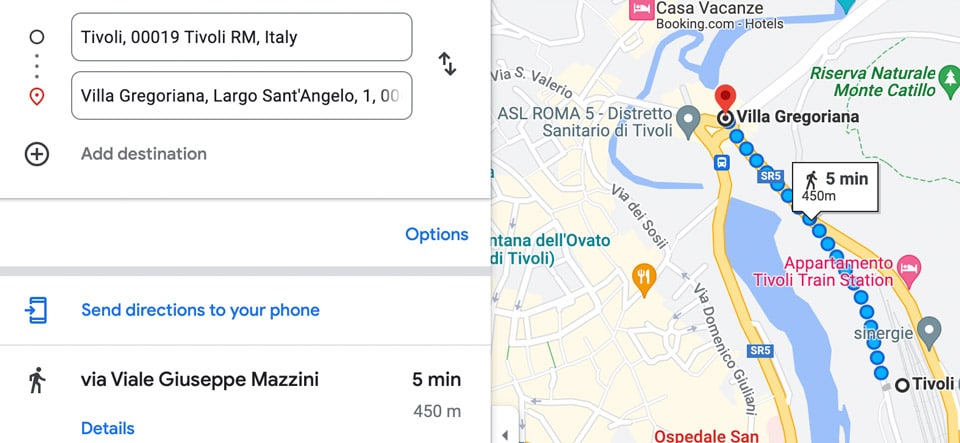

24849 views

Tivoli is a town with a long history, including the famous Hadrian Villa (Villa Adriana), Villa d’Este, villa Grigoriana, remains of Roman aqueducts, a medieval castle, and several beautiful churches. It is one of the best options for a day trip from Rome that will not leave anyone indifferent.
Contents
ToggleBoth Villa d’Este and Villa Adriana are full of beautiful places. One surprises with its charming fountains, impressive arts, and views of Rome, while another is the historical gem that initially consisted of 35 marble buildings on more than 200 hectares.
The Villa d’Este in Tivoli, with its palace and garden, is one of the most remarkable and comprehensive illustrations of Renaissance culture at its most refined. Its innovative design and architectural components (fountains, ornamental basins, etc.) make this a unique example of an Italian 16th-century garden. The Villa d’Este, one of the first “Giardini delle meraviglie,” was an early model for European gardens.
Villa d’Este belonged to Cardinal Ippolito II d’Este, who was a great connoisseur of art. The project’s development to reconstruct the Villa began in 1550; however, the cardinal approved the final version only 10 years later. The author of the project was Pirro Ligorio, an architect and expert in his field who had previously been in the service of the papal court and had worked on such masterpieces as Bomarzo’s Monster Garden (Parco dei Mostri) and the papal palace in the Vatican (Casino di Pio IV in the Vatican). His greatest masterpiece, however, was the Villa d’Este.
The villa’s luxurious design emphasized its status as a cultural center. The interior decoration of the castle began in 1563, and by the time of the death of the cardinal (1572) was almost completed.
The renovation of the park began in 1605 by Ippolito’s successor, Alessandro d’Este, who hired the great architect Gian Lorenzo Bernini for this purpose. Unfortunately, in the 18th century, due to the lack of proper care, the Villa fell into a deplorable state: the water supply that fed the numerous fountains was outdated, and the statues and decorative buildings began to crumble.
The estate passed into the possession of Franz Habsburger. Later, right before the First World War, the new owner of the Villa became Archduke Franz Ferdinand. Finally, at the end of hostilities, the state nationalized the Villa. The last restoration was carried out after the end of World War II.

Entrance fees are:
You can purchase tickets on the official website
The main Villa d’Este building is open from 08:45 – 19:45 every day except Monday when it opens at 14:00. You can access Tivoli Gardens from 08:30, but the gardens close at different times during the year:
The Hadrian’s Villa (Villa Adriana) is a magnificent complex of ancient structures built in the second century AD in Tivoli by Hadrian, the Roman emperor. It unites the most acceptable characteristics of Egyptian, Greek, and classical Roman architecture.
Villa Adriana was built because Hadrian, dissatisfied with the palace on Palatine Hill, wanted a place to escape. Several successors inhabited it after his death but finally fell out of use and were left in ruins, then stolen.
A copy of a sanctuary close to Alexandria is one of the Villa’s key highlights. It is a large pool surrounded by columns and adorned with caryatid statues.
Also, a building known as the Maritime Theatre, a circular pool surrounded by columns with an island in the middle, is situated among the libraries, restrooms, guest houses, gardens, fountains, and ponds. There is a small Roman villa on the island.

Entrance fees are:
One of the most significant buildings in the old acropolis of Tivoli is the Temple of Vesta. It is close to the Sibyl Temple. The Ponte Gregoriano provides access to the temple through a gate (bridge). The most well-known structure in ancient Tibur dates to the first century BC.
It was likely dedicated to Tiburon, the hero who gave the city its name, or perhaps to Vesta, the goddess of the hearth whose cult was conducted by the Vestals. The temple, with its beautiful round shape, looks out over spectacular views. Italian and international artists and wealthy aristocrats who used their wealth to commission paintings have made the Temple of Vesta their most popular subject over the years.
Villa Gregoriana, a gorgeous natural park close to Rome, is a complex of wooded gardens, pathways, waterfalls, and flora that stretches to the foot of the ancient acropolis. When 19th-century artists and aristocrats visited the old city of Tibur as part of their “grand tour,” they had to see this magnificent, untouched location, which Pope Gregory XVI had commissioned sometime around 1834.
The Fondo Ambiente Italiano, often known as FAI (the Italian Environmental Fund), is in charge of protecting and managing the entire area surrounding the Villa. It is regarded as one of a kind in the world since it is a location where the remarkable beauty of the surrounding landscape coexists with the priceless marble and old villa ruins of Publius Manlius Vopisco.
Both the Grottoes of Neptune or Grottoes of the Sirens, river-eroded caves, and the Great Waterfall are world-famous highlights of Villa Gregoriana. The Gregorian Bridge, an extraordinary building, commissioned by Pope Gregory XVI and connects the park to Tivoli’s old town center, is located next to the remarkable Villa. The historic acropolis and the Aniene valley may be seen well from the bridge.

Entrance fees are:
Our partners organize one-day group tours to Villa Adriana and Villa d’Este from Rome. The duration is about 7 hours, and you explore both villas with a professional tour guide.
The tour starts from the area near the Colosseum, so it is very convenient to get there from any part of the city. First, you head to Villa Adriana from Rome, where you spend about 1.5-2 hours, and then, by lunchtime, you arrive at the historical center of Tivoli.
The feature I liked is that you have free time to explore Tivoli and have lunch in one of the local restaurants without being in a hurry. After the lunch break, the group meets near the entrance to Villa d’Este to start an adventure to one of the most worldwide known villas. Do not worry; you will have enough time to take beautiful photos and buy souvenirs.
Here’s the link to the group tour I’ve visited
If you want to visit the main attractions of Tivoli in the most comfortable way, then the best choice is a private tour with a professional guide. You will be picked up directly from your hotel in Rome, taken to Tivoli, and told exciting stories and interesting facts.
The tour costs 400 to 700 euros, depending on the duration and number of people. For details, please send an inquiry via this contact form.
There are several ways to get from Rome to Tivoli on your own. The fastest, cheapest, and easiest way to get to Tivoli is by train.
The FL2 Trenitalia regional trains to Tivoli depart approximately every hour from Roma Tiburtina and Roma Termini. You can also take any train headed to Avezzano. The average price per ticket is 2.60-3 euros one-way. This is the cheapest and most convenient way to reach Tivoli in 47-70 minutes (depending on the train).
Based on my experience, the most convenient time is 09:03 from Roma Termini; the journey time is 47 minutes.
At the Ponte Mammolo stop on Rome’s Metro line B, blue COTRAL buses depart for Tivoli. Depending on traffic, the trip to Tivoli takes around an hour. Monday through Saturday, departures are every 10 to 15 minutes; Sunday departures are less frequent.
A private transfer is the most comfortable and secure way to Tivoli. You can book a car on our website, rome4.us.
Tivoli has 3 of my favorite restaurants where you can find both traditional Italian dishes and typical dishes from the Lazio region:
Sibilla restaurant is a unique gastronomical experience along with incredible views of Tivoli. This is a perfect place for a beautiful date, wedding celebration, family lunch or dinner, or just for a meeting with friends. There are vegetarian, vegan, and gluten-free options on the menu. Must visit!
Osteria la Briciola is one of the top seafood restaurants in Tivoli. If you are looking for a combination of excellent service, high-quality food, and beautiful views – this place is for you. There are vegetarian, vegan, and gluten-free options on the menu. Also, don’t forget to try their desserts!
Viva l’Oste is a charming restaurant near the entrance to villa d’Este. It is a family-run place with “menu of the day” options, which make its dishes unique and fresh. Among dishes are local delicacies, traditional Roman dishes, homemade pasta and desserts, and sometimes unusual receipts worth a try.
I hope my tips help you plan your trip to Tivoli from Rome. Of course, you can always ask questions in the comments or ask for an individual consultation.
Author: Kate Zusmann
This website uses cookies. For more info read the cookies policy
Rome.us © 2025. Created with love by Roman experts and guides.